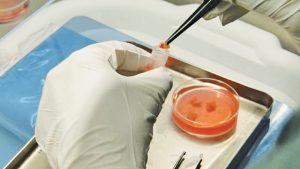 Danish scientists have made a potentially momentous breakthrough with their development of an artificial ovary created from human cells. It is hoped that this artificial ovary could be implanted back into women and restore their fertility after cancer treatment. The research was presented at the annual meeting of the European Society of Human Reproduction and Embryology in Barcelona, Spain.
Danish scientists have made a potentially momentous breakthrough with their development of an artificial ovary created from human cells. It is hoped that this artificial ovary could be implanted back into women and restore their fertility after cancer treatment. The research was presented at the annual meeting of the European Society of Human Reproduction and Embryology in Barcelona, Spain.
Cancer treatments can cause severe damage to the ovaries, reducing or eliminating the production of eggs and making pregnancy considerably more difficult. In some cases, doctors may offer younger cancer patients the option to remove or freeze all or part of an ovary for re-transplantation after treatment. However, this method of continued fertility has major risks of reintroducing cancer cells, as some cancers can spread to the ovaries. The next best option for women diagnosed with cancer is to have their eggs frozen before treatment, though that can affect the cells’ viability.
Researchers from the Rigshospitalet in Copenhagen, Denmark, created their artificial ovary by taking ovarian tissue from cancer patients and stripping it of cells. They then transplanted this newly constructed scaffold into mice. The researchers found that the scaffold could support the survival and growth of human egg follicles, with a quarter of them surviving for at least three weeks while nourishing blood vessels grew around the ovary.
Susanne Pors, an author of the research and a postdoctoral fellow in the Laboratory of Reproductive Biology at the University Hospital of Copenhagen Rigshospitalet, said, “We have many more studies to do, but this is a proof-of-concept showing that human eggs can survive on a newly constructed scaffold.” If the artificial ovary option works, it could restore a woman’s fertility using their eggs and possibly donor tissue. Artificial ovaries could also one day help relieve women of some of the symptoms of the menopause.
It is important to note that the research has not been published in a peer-reviewed journal and has not been tested inside humans. It could take up to 10 years before human trials are held.
